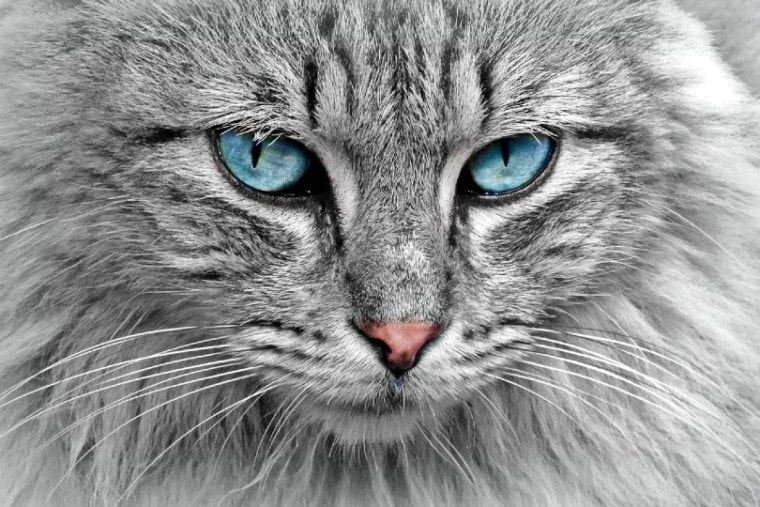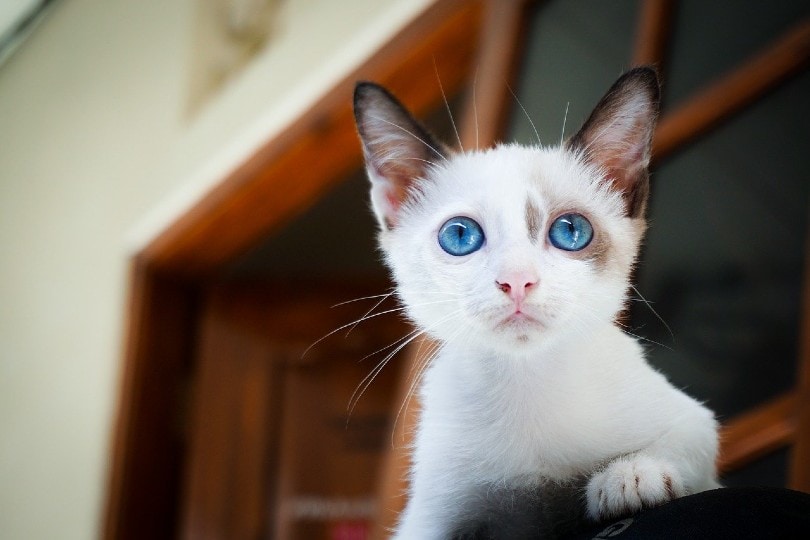Cats Eye Color Turned From Blue to Orange

If the eyes are the window to the soul, then cats most definitely have beautiful souls! Our cats have such gorgeous and unique eyes that come in a variety of colors, but what if you notice your cat's eyes look a little different? Can an adult cat's eyes actually change color?
Essentially,an adult cat's eyes do not change color. If you have noticed a difference in the color of your cat's eyes, it might just be a change in the light, or it could be a health issue.
We'll go over some of the common health problems that might affect your cat's eyes. We hope this will give you some good information, so you know what to look out for.

Kitten Eyes
Most of us already know that there is one time in a cat's life when there is a change in eye color. Kittens are all born with eyes that are blue in color. Their eyes gradually change into the color they will have for the rest of their lives.
The reason kittens have blue eyes is that their eyes don't have any pigment when they are born. So, the blue color in their eyes isn't technically a color; it's more of an optical illusion.
Kittens are born blind with their eyes sealed shut, which don't open until they are about 8 to 12 days old. Once their eyes are fully open, you'll see that their eyes are blue, which won't change color until they are about 7 weeks old.
When the kitten's eyes begin to change color, the cells in the eyes are starting to produce melanin. Melanin is a kind of complex pigment that makes the pigmentation, or color, in our skin, hair, and eyes.

Adult Cat Eyes
A cat's eye color is sometimes determined by her coat color and breed. Cats that are predominantly or all white tend to have blue, gold, copper, or green eyes, and pointed cats (such as Himalayans and Siamese) usually have blue eyes.
The color is also determined by how much melanin the eye produces. The higher the amount of melanin, the more intense and brighter the eye color will be, so green has a lower amount of melanocytes, whereas orange has a very high proportion of melanocytes.
Essentially, the fur, skin, and eye color are not actually determined by the color of melanin but by how much melanin is present.
If your kitten still has blue eyes by the time she's 8 weeks old, she'll probably retain her blue eyes into adulthood. Once the kitten's eye color has come in, this is the color she will have throughout her adult life.
Cat Eye Colors
The color of cat eyes has quite a wide range.
The more common colors are:
- Green: This is one of the most common eye colors for cats, and like blue eyes, there is much less melanin.
- Yellow:You'll often see black cats with yellow eyes, but the intensity of the color truly varies from cat to cat. It can range from a dark and dull yellow to a vibrant gold.
- Blue: Blue isn't as common amongst the average cat, but it is with a number of breeds. Many white cats with blue eyes have a higher chance of being deaf than any other color. Also, blue-eyed cats are a little more sensitive to light.
- Copper:This is another color found more commonly in black cats. It's rarer than many other colors.
- Orange: Orange is obviously a much more intense color, thanks to the melanocytes.
- Amber: Quite rare but can be seen in Sphynx, Bengals, and the Norwegian Forest.
- Hazel: Definitely not a common eye color at all, but you might see Abyssinian, Cornish Rex, and Bengals with this color. It tends to be a combination of green and yellow.
Then there are the more unusual characteristics that can sometimes be found in a cat's eyes and are usually rare.
Rare cat eye colors:
- Dichroic:This is when a cat can have 2 different colors in one eye. This is a particularly rare and very striking condition. One eye can be solid, and the other dichroic or both can be dichroic. Half of the eye might be blue, and the other half golden. You get the picture.
- Odd-Eyed:This is also called heterochromia. One eye is usually blue, and the other is typically green but can also be yellow or brown.
If you're wondering what the most common eye color in cats is, it is usually some form of gold, yellow, or a greenish-yellow.

What Causes Eye Color Change in Adult Cats?
It's quite rare for an adult cat to suddenly have a change in eye color without it being a health issue.
Sometimes a change in the ambient light might make it seem like your cat's eyes are changing color, but it really is just the light refracting off of the eye.
Then there are the pupils. When your cat is very excited or when it's nighttime, the pupils will dilate, giving your cat a very Puss-in-Boots appearance.
And lastly, there are the glowing eyes that you sometimes see staring at you from a dark room or corner. Interestingly, if your cat has any eye color but blue, you'll see a yellow or golden glow when light is reflected off the eye. But if you have a blue-eyed cat, the eyes can even glow red!

Possible Health Problems
If there's a change in your cat's eye color, it's a possibility that it's a sign that there's a health issue.
1. Anterior Uveitis
This condition has symptoms that affect the eyes, which include redness of the eyes, cloudy or dull eyes, and the color of the iris might look different or uneven.
Other symptoms include:
- Pain
- Tearing
- Squinting
- Discharge
- Swollen eyeball
There are many causes such as:
- Tumor
- Trauma/injury
- Autoimmune diseases
- Cancer
- Lens protein in the eye fluid
- Metabolic diseases
- Infections (from fungi, bacteria, parasites, rickettsia, or toxoplasmosis)
2. Jaundice
This is caused by obstructed bile ducts and can cause yellow discoloration of the skin, gums, and eyes.
Causes can include:
- Destruction of red blood cells
- Obstruction of the bile duct
- Liver disease
3. Glaucoma
This condition occurs when the eye experiences high pressure and can eventually lead to the loss of sight.
Symptoms can include:
- Excessive blinking
- Reddened blood vessels ineye
- Permanently dilated eye
- Eye has cloudy/milky appearance
In later stages, the cat might lose her appetite, will become lethargic and uninterested in playing, and you might see her pressing her head against a wall to relieve headaches.
4. Cataracts
This is another condition of the eye that can also lead to blindness. The primary symptom is a cloudiness of the eye. However, this occurs when the cataract has progressed to a later stage.
Causes:
- Old age
- Uveitis
- Exposed to toxic substance or radiation
- Low level of calcium in the blood
- Diabetes mellitus
5. Portosystemic Liver Shunt
Some cats are born with this condition. Any toxins that enter the cat's blood are moved through the portal vein to the liver, where they are detoxified and eventually removed. The portosystemic shunt is an abnormal vessel that diverts the blood away from the liver and moves it directly to the heart.
The cat becomes quite severely ill since the toxins aren't detoxified and removed. One of the symptoms is that the cat's eyes can change to a copper color.
Other symptoms include:
- Lethargy
- Unconsciousness
- Seizures
- Walking in circles
- Trembling
- Pressing head on the wall
- Excessive drooling
- Weight loss
- Appear to be hallucinating
The truth is, if you can rule out your cat's eye color change as a trick of the light (or any other reasonable explanation), then you probably have nothing to worry about. But otherwise, you should take your cat to the vet as soon as possible!
Most of these conditions are quite serious, and in the long run, a change in your adult cat's eye color might be something your vet will need to look after.

Conclusion
So, we've learned that while a kitten's eye color does change when they start to grow a little older, adult cats really don't experience eye color change.
You truly know your cat better than anyone else, so if you notice a change that wasn't there before, it's best to talk to your vet. And if nothing is wrong, at least your mind will be at ease.
Taking the best care of your cat and her beautiful eyes is essential. You want her around for a long time.
Another interesting article on the topic:
- Glow-in-the-Dark Cats — Genetically Modified Cats Explained
- Conjunctivitis in Cats (Pink Eye): Treatments, Symptoms & Prevention
- Deafness & Blindness In White Cats: Here's What The Statistics Say
Featured Image Credit: cocoparisienne, Pixabay
Source: https://petkeen.com/do-cats-eyes-change-color/
0 Response to "Cats Eye Color Turned From Blue to Orange"
Post a Comment